Identification and characterization of the 480-kilodalton template-specific RNA-dependent RNA polymerase complex of red clover necrotic mosaic virus
- PMID: 20375154
- PMCID: PMC2876630
- DOI: 10.1128/JVI.00054-10
Identification and characterization of the 480-kilodalton template-specific RNA-dependent RNA polymerase complex of red clover necrotic mosaic virus
Abstract
Replication of positive-strand RNA viruses occurs through the assembly of membrane-associated viral RNA replication complexes that include viral replicase proteins, viral RNA templates, and host proteins. Red clover necrotic mosaic virus (RCNMV) is a positive-strand RNA plant virus with a genome consisting of RNA1 and RNA2. The two proteins encoded by RNA1, a 27-kDa protein (p27) and an 88-kDa protein containing an RNA-dependent RNA polymerase (RdRP) motif (p88), are essential for RCNMV RNA replication. To analyze RCNMV RNA replication complexes, we used blue-native polyacrylamide gel electrophoresis (BN/PAGE), which enabled us to analyze detergent-solubilized large membrane protein complexes. p27 and p88 formed a complex of 480 kDa in RCNMV-infected plants. As a result of sucrose gradient sedimentation, the 480-kDa complex cofractionated with both endogenous template-bound and exogenous template-dependent RdRP activities. The amount of the 480-kDa complex corresponded to the activity of exogenous template-dependent RdRP, which produced RNA fragments by specifically recognizing the 3'-terminal core promoter sequences of RCNMV RNAs, but did not correspond to the activity of endogenous template-bound RdRP, which produced genome-sized RNAs without the addition of RNA templates. These results suggest that the 480-kDa complex contributes to template-dependent RdRP activities. We subjected those RdRP complexes to affinity purification and analyzed their components using two-dimensional BN/sodium dodecyl sulfate-PAGE (BN/SDS-PAGE) and mass spectrometry. The 480-kDa complex contained p27, p88, and possible host proteins, and the original affinity-purified RdRP preparation contained HSP70, HSP90, and several ribosomal proteins that were not detected in the 480-kDa complex. A model for the formation of RCNMV RNA replication complexes is proposed.
Figures
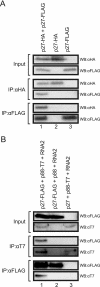
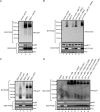
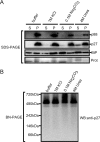
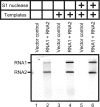
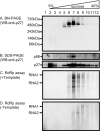
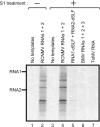


Similar articles
-
Template recognition mechanisms by replicase proteins differ between bipartite positive-strand genomic RNAs of a plant virus.J Virol. 2011 Jan;85(1):497-509. doi: 10.1128/JVI.01754-10. Epub 2010 Oct 27. J Virol. 2011. PMID: 20980498 Free PMC article.
-
Interactions between p27 and p88 replicase proteins of Red clover necrotic mosaic virus play an essential role in viral RNA replication and suppression of RNA silencing via the 480-kDa viral replicase complex assembly.Virology. 2010 Nov 25;407(2):213-24. doi: 10.1016/j.virol.2010.07.038. Epub 2010 Sep 15. Virology. 2010. PMID: 20828775
-
Differential roles of Hsp70 and Hsp90 in the assembly of the replicase complex of a positive-strand RNA plant virus.J Virol. 2012 Nov;86(22):12091-104. doi: 10.1128/JVI.01659-12. Epub 2012 Aug 29. J Virol. 2012. PMID: 22933272 Free PMC article.
-
Non-template functions of viral RNA in picornavirus replication.Curr Opin Virol. 2011 Nov;1(5):339-46. doi: 10.1016/j.coviro.2011.09.005. Curr Opin Virol. 2011. PMID: 22140418 Free PMC article. Review.
-
How does the polymerase of non-segmented negative strand RNA viruses commit to transcription or genome replication?J Virol. 2024 Aug 20;98(8):e0033224. doi: 10.1128/jvi.00332-24. Epub 2024 Jul 30. J Virol. 2024. PMID: 39078194 Free PMC article. Review.
Cited by
-
Roles of superoxide anion and hydrogen peroxide during replication of two unrelated plant RNA viruses in Nicotiana benthamiana.Plant Signal Behav. 2017 Jun 3;12(6):e1338223. doi: 10.1080/15592324.2017.1338223. Epub 2017 Jun 8. Plant Signal Behav. 2017. PMID: 28594275 Free PMC article.
-
The mechanisms of siRNA selection by plant Argonaute proteins triggering DNA methylation.Nucleic Acids Res. 2022 Dec 9;50(22):12997-13010. doi: 10.1093/nar/gkac1135. Nucleic Acids Res. 2022. PMID: 36477368 Free PMC article.
-
Template recognition mechanisms by replicase proteins differ between bipartite positive-strand genomic RNAs of a plant virus.J Virol. 2011 Jan;85(1):497-509. doi: 10.1128/JVI.01754-10. Epub 2010 Oct 27. J Virol. 2011. PMID: 20980498 Free PMC article.
-
Hepatitis C virus NS2 coordinates virus particle assembly through physical interactions with the E1-E2 glycoprotein and NS3-NS4A enzyme complexes.J Virol. 2011 Feb;85(4):1706-17. doi: 10.1128/JVI.02268-10. Epub 2010 Dec 8. J Virol. 2011. PMID: 21147927 Free PMC article.
-
Hsp90 interacts specifically with viral RNA and differentially regulates replication initiation of Bamboo mosaic virus and associated satellite RNA.PLoS Pathog. 2012;8(5):e1002726. doi: 10.1371/journal.ppat.1002726. Epub 2012 May 24. PLoS Pathog. 2012. PMID: 22654666 Free PMC article.
References
-
- Basnayake, V. R., T. L. Sit, and S. A. Lommel. 2009. The Red clover necrotic mosaic virus origin of assembly is delimited to the RNA-2 trans-activator. Virology 384:169-178. - PubMed
-
- Bates, H. J., M. Farjah, T. A. M. Osman, and K. W. Buck. 1995. Isolation and characterization of an RNA-dependent RNA polymerase from Nicotiana clevelandii plants infected with red clover necrotic mosaic dianthovirus. J. Gen. Virol. 76:1483-1491. - PubMed
-
- Bonafé, N., M. Gilmore-Hebert, N. L. Folk, M. Azodi, Y. Zhou, and S. K. Chambers. 2005. Glyceraldehyde-3-phosphate dehydrogenase binds to the AU-rich 3′ untranslated region of colony-stimulating factor-1 (CSF-1) messenger RNA in human ovarian cancer cells: possible role in CSF-1 posttranscriptional regulation and tumor phenotype. Cancer Res. 65:3762-3771. - PubMed
-
- Brass, V., E. Bieck, R. Montserret, B. Wolk, J. Hellings, H. Blum, F. Penin, and D. Moradpour. 2002. An amino-terminal amphipathic alpha-helix mediates membrane association of the hepatitis C virus nonstructural protein 5A. J. Biol. Chem. 277:8130-8139. - PubMed
Publication types
MeSH terms
Substances
LinkOut - more resources
Full Text Sources
Research Materials

